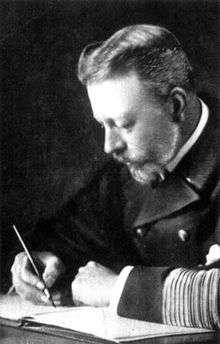Prince Henry of Prussia (1862–1929)
Prinz Albert Wilhelm Heinrich von Preußen, or Prince Henry of Prussia, Generalinspekteur der Marine (born Albert Wilhelm Heinrich, 14 August 1862 – 20 April 1929), was a younger brother of German Emperor William II and a Prince of Prussia. He was also a grandson of Queen Victoria. A career naval officer, he held various commands in the Imperial German Navy and eventually rose to the rank of Grand Admiral.
Biography
Born in Berlin, Prince Henry of Prussia was the third child and second son of eight children born to Crown Prince Frederick (later Emperor Frederick III), and Victoria, Princess Royal of the United Kingdom (later Empress Victoria and in widowhood Empress Frederick), eldest daughter of the British Queen Victoria. Henry was three years younger than his brother, the future Emperor William II (born 27 January 1859).
After attending the gymnasium in Kassel, which he left in the middle grades in 1877, the 15-year-old Henry entered the Imperial Navy cadet program. His naval education included a two-year voyage around the world (1878 to 1880), the naval officer examination (Seeoffizierhauptprüfung) in October 1880, and attending the German naval academy (1884 to 1886).
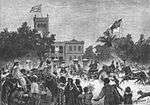
Early commands
As an Imperial Prince, Henry quickly achieved command. In 1887, he commanded a torpedo boat and simultaneously the First Torpedo Boat Division; in 1888 the Imperial yacht SMY Hohenzollern; from 1889 to 1890 the second-class cruiser SMS Irene, the armored coastal defense ship SMS Beowulf, and the capital ships SMS Sachsen and SMS Wörth.
Squadron commands
From 1897, Prince Henry commanded several naval task forces; these included an improvised squadron that took part with the East Asia Squadron in consolidating and securing the German hold on the region of Kiaochow and the port of Tsingtao in 1898. The prince’s success was more of the diplomatic than the military variety; he became the first European potentate ever to be received at the Chinese imperial court. In 1899 he became officially the commander of the East Asia Squadron, later of a capital-ship squadron and in 1903 commander of the Baltic Sea naval station. From 1906 to 1909, Henry was commander of the High Seas Fleet. In 1909, he was promoted to Grand Admiral.
World War I
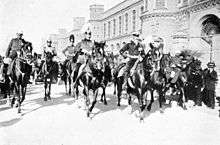
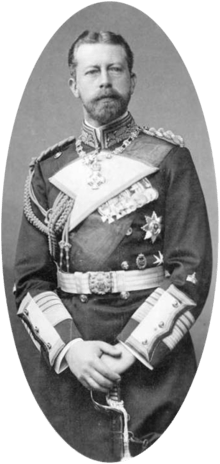
At the beginning of World War I, Prince Henry was named Commander-in-Chief of the Baltic Fleet. Although the means provided him were far inferior to Russia’s Baltic Fleet, he succeeded, until the 1917 Revolution, in putting Russia’s naval forces far on the defensive, and hindered them from making attacks on the German coast. After the end of hostilities with Russia, his mission was ended, and Prince Henry simply left active duty. With the war’s end and the dissolution of the monarchy in Germany, Prince Henry left the Navy.
Family
On 24 May 1888, Henry married Princess Irene of Hesse and by Rhine, his first cousin. The marriage produced three children:
| Name | Picture | Birth | Death | Notes |
|---|---|---|---|---|
| Waldemar William Louis Frederick Victor Henry | 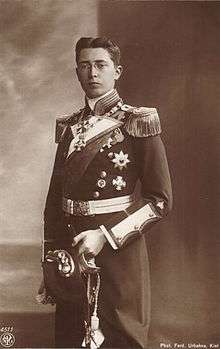 | 20 March 1889 | 2 May 1945 | Married Princess Calixta of Lippe-Biesterfeld, but had no issue. |
| William Victor Charles Augustus Henry Sigismund | 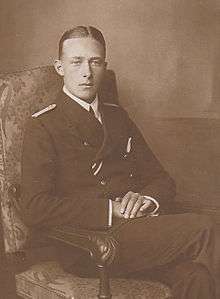 | 27 November 1896 | 14 November 1978 | Married Princess Charlotte of Saxe-Altenburg, had issue. |
| Henry Victor Louis Frederick | 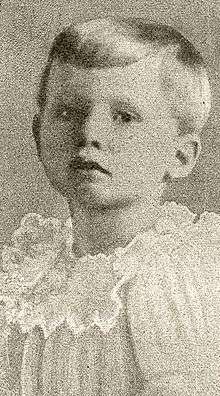 | 9 January 1900 | 26 February 1904 | Was a haemophiliac and died aged four after bumping his head[1] |
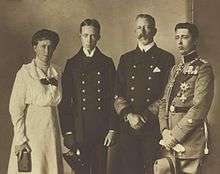
Their sons Waldemar and Heinrich were both hemophiliacs, a disease which they inherited through Irene from the maternal grandmother of both of their parents, Queen Victoria, who was a carrier.
Personality and private life
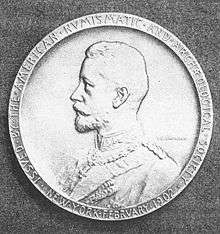
Henry had little in common with his brother, the German Emperor. He lacked, for example, William II's erratic nature and egotism. The prince was truly popular in Northern Germany, and on account of his humble and open manner was beloved by those under his command. On foreign travels, he was a good diplomat, who, unlike his brother, was able to strike the right tone. Thus, on his 1902 trip to the United States, Henry made a favorable impression with the critical American press and succeeded in winning the sympathy of more than just the numerous German-American segment of the population.
As a naval officer, Henry had a profession that completely satisfied him and that he loved. He was thoroughly a pragmatist. He received one of the first pilot’s licenses in Germany, and was judged a spirited and excellent seaman. He was dedicated to modern technology and was able to understand quickly the practical value of technical innovations. A yachting enthusiast, Prince Henry became one of the first members of the Yacht Club of Kiel, established by a group of naval officers in 1887, and quickly became the club's patron.
Henry was interested in motor cars as well and supposedly invented a windshield wiper[2] and, according to other sources, the car horn. In his honor, the Prinz-Heinrich-Fahrt (Prince Heinrich Tour) was established in 1908, like the earlier Kaiserpreis a precursor to the German Grand Prix. Henry and his brother William gave patronage to the Kaiserlicher Automobilclub (Imperial Automobile Club).
Henry also was an early proponent of introducing submarines and airplanes. He had a steamship converted into a primitive aircraft carrier for operations in the Baltic Sea.
Henry respected his brother, but this attitude was not returned in the same measure. William kept his younger brother far from politics, although Henry served as his representative as long as the Crown Prince was still in his minority. Henry complied with this, for he did not interest himself in either politics or grand strategy. He did not recognize what political effect the German naval build-up would entail, and also would not have been in the position to move his brother toward a different policy.
After the German Revolution, Henry lived with his family in Hemmelmark near Eckernförde, in Schleswig-Holstein. He continued with motor sports and sailing and even in old age was a very successful participant in regattas. He popularized the Prinz-Heinrich-Mütze ("Prince Henry cap"), which is still worn, especially by older sailors.
In 1899, Henry received an honorary doctorate (Doctor of Engineering honoris causa) from the Technical University of Berlin. Also in foreign countries he received numerous similar honors, including an honorary doctorate (LL.D.) from Harvard University in March 1902, during his visit to the United States.[3]
Prince Henry died of throat cancer, as his father had, in Hemmelmark on 20 April 1929.[4]
George Burroughs Torrey painted a portrait of him.
Naval career and advancement
- Unterleutnant zur See, 14 August 1872; Basic Training and Naval Academy 1877-1878
- Leutnant zur See, 18 October 1881; Training Cruises and Naval Academy 1878-1882
- Kapitänleutnant, 18 October 1884; Executive Officer, Armored Cruiser SMS Oldenburg, 1886
- Korvettenkapitän, 18 October 1887; Commander, 1st Torpedo Boat Division, 1887; Commander, Imperial Yacht SMY Hohenzollern, 1888
- Kapitän zur See, 27 Januar 1889; ; Commander, Cruiser SMS Irene, 1889–1890; Commander, Armored Coastal Defense Ship SMS Beowulf, 1892; Commander, Armored Cruiser SMS Sachsen, 1892–1894; Commander, Armored Ship of the Line SMS Wörth, 1894–1895
- Konteradmiral, 15 September 1895; Commander, 2nd Division, 1st Battle Squadron, 1896–1897; Commander, 2nd Division, Cruiser Squadron, 1897–1899
- Vizeadmiral, 5 December 1899; Commander, Cruiser Squadron, 1899–1900; Commander, 1st Battle Squadron, 1900–1903
- Admiral, 13 September 1901;[5] Commanding Admiral, Baltic Sea Naval Command, 1903–1906, Commander, High Seas Fleet, 1906–1909
- Großadmiral, 4 September 1909; Inspector General of the Imperial Navy, 1909–1918; Commander-in-Chief, Baltic Fleet, 1914–1918
Regimental commissions and honorary ranks
German
- 1. Garde-Regiment zu Fuß (Royal Prussian 1st Regiment of Foot Guards) – Leutnant (Second Lieutenant) through Generaloberst im Range eines Generalfeldmarschalls (Colonel-General in the Rank of Field Marshal), 1871 - 1918[6]
- Kgl. Sächs. 2. Grenadier-Regiment Kaiser Wilhelm, König von Preußen Nr. 101 (Royal Saxon 2nd Grenadier Regiment)
- Kgl. Bayerisches Artillerie-Regiment Nr. 8 (Royal Bavarian 8th Artillery Regiment) – Generaloberst im Range eines Generalfeldmarschalls and Chef (Colonel in Chief)[7]
- 1. Großherzogl. Hessisches Feldartilleree-Regiment 25 (Grand Duchy of Hesse 2nd Artillery Regiment)[6]
- Fußilier-Regiment “Prinz Heinrich von Preußen” (Brandenburgisches) Nr 35 (The Brandenburg Fusilier Regiment) - Generaloberst im Range eines Generalfeldmarschalls and Chef (Colonel in Chief)[8]
Foreign
- Austria-Hungary K.u.K. Infantry Regiment Nr. 20 – Oberstinhaber (Colonel in Chief)[6]
- Austria-Hungary K.u.K. Kriegsmarine (Navy) – Vizeadmiral (vice admiral)[6]
- Austria-Hungary K.u.K. Kriegsmarine - Konteradmiral (rear-admiral) 1899[9]
- British Royal Navy – Admiral (Honorary) 13 September 1901[5][6]
- British Royal Navy - Vice-Admiral (Honorary) 5 February 1901.[10]
- Russian Imperial Dragoon Regiment Nr. 33 – Colonel[6]
Titles, styles, and honours [6]
Titles
- 14 Aug 1862 – 20 April 1929 – His Royal Highness Prince Henry of Prussia
Prussian
- Order of the Black Eagle, Knight, 1872
- Order of the Red Eagle, Knight Grand Cross, 1872 (by statute of the Order of the Black Eagle, for princes of Prussia)
- Prussian Crown Order, Knight First Class, 1872 (by statute of the Order of the Black Eagle, for princes of Prussia)
- Royal House Order of Hohenzollern, Grand Commander with collar chain
- Princely House Order of Hohenzollern, Knight First Class
- Johanniterorden (Order of St. John, Bailiwick of Brandenburg)
Non-Prussian German
- Order of Albert the Bear (Anhalt), Knight Grand Cross
- House Order of Fidelity (Baden), Knight Grand Cross
- Order of Berthold I (Baden), Knight Grand Cross
- Knight Grand Cross of the Order of the Zähringer Lion (Baden)
- Order of St. Hubert (Bavaria), Knight
- Order of Henry the Lion (Brunswick), Knight First Class
- House Order of the Golden Lion (Hesse-Kassel), Knight
- Ludwig Order (Hesse-Darmstadt), Knight Grand Cross
- Order of the Wendish Crown (Mecklenburg), Knight Grand Cross, with Crown and Diamonds
- House Merit Order of Peter Friedrich Ludwig (Oldenburg), Knight Grand Cross with Golden Crown
- Order of the Rue Crown (Saxony), Knight
- Order of the White Falcon (Saxe-Weimar-Eisenach), Knight Grand Cross
- Saxe-Ernestine House Order (Saxe-Altenburg, Saxe-Coburg & Gotha, and Saxe-Meiningen), Knight Grand Cross
- Order of the Württemberg Crown (Württemberg), Knight Grand Cross
Foreign
- Royal Hungarian Order of St. Stephen (Austria-Hungary), Knight Grand Cross
- Order of Leopold (Belgium), Grand Cordon
- Order of Christ's Cross (Brazil), Knight Grand Cross
- Order of the Double Dragon (China), 1st Grade II Class
- Order of the Elephant (Denmark), Knight
- Order of the Redeemer (Greece), Knight Grand Cross
- Royal Order of Kalākaua I (Kingdom of Hawaii), Knight Grand Cross, 1881
- Order of the Annunciation (Italy), Knight
- Order of Saints Maurice and Lazarus (Italy), Knight Grand Cross
- Order of St. Joseph (Italian Grand Duchy of Tuscany), Knight Grand Cross
- Order of the Chrysanthemum (Japan), Grand Cordon
- Order of the Gold cheok(Korean Empire),
Grand Cordon
- Order of the Netherlands Lion (Netherlands), Knight Grand Cross
- Royal Norwegian Order of St. Olav (Norway), Knight Grand Cross
- Military Order of Christ (Portugal), Grand Cross
- Order of the Tower and Sword (Portugal), Grand Cross
- Order of the Star of Romania (Romania), Knight Grand Cross
- Order of St. Andrew the First Called (Russia), Knight
- Order of the White Eagle (Serbia), Knight Grand Cross
- Order of the Golden Fleece (Spain), Knight
- Order of Naval Merit (Spain), Knight Fourth Class (Grand Cross)
- Order of Seraphim (Sweden), Knight
- Order of Osmanie (Ottoman Turkey), Knight Grand Cross
- Order of the Garter (United Kingdom), Knight (expelled in 1915)
- Order of the Bath (United Kingdom), Knight Grand Cross (civil)
- Royal Victorian Chain (UK) - 1902
- Supreme Order of Christ (Vatican), Knight
- Order of the Liberator Simon Bolivar (Venezuela), Collar
Honorary degrees and offices
- Freedom of the City of New York, 25 February 1902, during his visit to the city.[11]
- Freedom of the City of Philadelphia, 10 March 1902, during his visit to the city.[12]
- Honorary doctorate (LL.D.) from Harvard University, 6 March 1902.[3]
Ancestry
References
- ↑ The Royal Forums
- ↑ "untitled". The Day Book. Chicago. June 13, 1914. p. 10. Retrieved August 20, 2014.
Admiral Prince Henry of Prussia, brother of the kaiser, has invented and patented an electrical device for cleaning windows of automobiles in rainy or frosty weather. The device is set in operation by the pressing of a button.
- 1 2 "Latest intelligence - Prince Henry in America". The Times (36709). London. 7 March 1902. p. 3.
- ↑ "Died". Time (magazine). 29 April 1929. Retrieved 2008-06-06.
Prince Henry of Hohenzollern, 66, of Berlin, brother of onetime Kaiser Wilhelm II, Wartime commander of Germany's Baltic fleet; of heart disease and pneumonia; in Berlin. Popular Prince Henry visited the U. S. in 1884 and 1902, was caricatured in many a newspaper passing under festal arches of sausages, pretzels.
- 1 2 The London Gazette: no. 27365. p. 6711. 15 October 1901.
- 1 2 3 4 5 6 7 Handbuch..., 1904, p. 2
- ↑ Der Rittmeister Militaria, LLC: http://www.derrittmeister.com/royalty.htm
- ↑ Handbuch..., 1904, p. 2, and Der Rittmeister Militaria, LLC: http://www.derrittmeister.com/royalty.htm
- ↑ "The Triple Alliance". The Times (36062). London. 10 February 1900. p. 7.
- ↑ The London Gazette: no. 27281. p. 766. 5 February 1901. Retrieved 11-10-2012.
- ↑ "Prince Henry in America". The Times (36701). London. 26 February 1902. p. 5.
- ↑ "Latest intelligence - Prince Henry in America". The Times (36712). London. 11 March 1902. p. 5.
Further reading
- Harald Eschenburg. Prinz Heinrich von Preußen - Der Großadmiral im Schatten des Kaisers. Heide, 1989, ISBN 3-8042-0456-2. [Translation of title: Prince Heinrich of Prussia - The Grand Admiral in the Shadow of the Emperor.]
- John Van der Kiste. Prince Henry of Prussia. 2015
External links
| Wikimedia Commons has media related to Prince Heinrich of Prussia. |
| Political offices | ||
|---|---|---|
| Preceded by New post |
Commander-in-Chief of High Seas Fleet of the Imperial German Navy 1907–1909 |
Succeeded by Henning von Holtzendorff |
